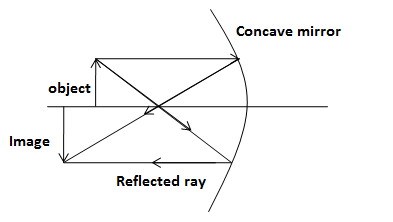
A real image formed when two or more
A. Reflected rays meet
B. Refracted rays meet
C. Reflected rays appear to meet
D. Rays actual meet
Answer
557.4k+ views
Hint: A real image can be focused on the screen but the virtual image cannot be focused on the screen. Refer to the ray diagrams of image formation by convex lens and concave mirror to answer this question.
Complete answer:
We will answer this question with the help of a ray diagram of image formation by both lens and mirror. To do so, we should first know that the real image formed by a concave lens is always virtual and the image formed by a convex lens may be real or virtual depending upon the position of the object on the principle axis. Image formed by a concave mirror may be virtual or real and the image formed by a convex mirror is always virtual.
Now, let’s consider the image formation by convex lens as shown in the figure below,

This is a real image since it is formed by converging rays refracted from the lens. Therefore, the real image can be formed when refracted rays meet. Thus, the option (A) is correct.
Now, let’s check whether the real image forms when reflected rays meet. We know that the concave mirror forms an image by converging rays reflected from the mirror.

We know that an image formed by a concave lens by focusing converging rays is a real image. Therefore, we can say that real images also form when reflected rays meet. Thus, the option (B) is correct.
When the image is formed by back tracing the refracted rays of the concave lens, the image is known as virtual image. In this process, the rays appear to meet at a point but they are not either refracted rays or reflected rays. Therefore, the option (C) is incorrect.
So, the correct answer is option (A), (B) and (D).
Note:
There is a basic difference between real image and virtual image. The real image can be projected on the screen and the virtual image cannot be projected on the screen. Therefore, you can answer this question by referring to this difference. Note that only reflected or refracted rays can be focused on the screen. By back tracing the refracted rays, you cannot focus them on the screen.
Complete answer:
We will answer this question with the help of a ray diagram of image formation by both lens and mirror. To do so, we should first know that the real image formed by a concave lens is always virtual and the image formed by a convex lens may be real or virtual depending upon the position of the object on the principle axis. Image formed by a concave mirror may be virtual or real and the image formed by a convex mirror is always virtual.
Now, let’s consider the image formation by convex lens as shown in the figure below,

This is a real image since it is formed by converging rays refracted from the lens. Therefore, the real image can be formed when refracted rays meet. Thus, the option (A) is correct.
Now, let’s check whether the real image forms when reflected rays meet. We know that the concave mirror forms an image by converging rays reflected from the mirror.

We know that an image formed by a concave lens by focusing converging rays is a real image. Therefore, we can say that real images also form when reflected rays meet. Thus, the option (B) is correct.
When the image is formed by back tracing the refracted rays of the concave lens, the image is known as virtual image. In this process, the rays appear to meet at a point but they are not either refracted rays or reflected rays. Therefore, the option (C) is incorrect.
So, the correct answer is option (A), (B) and (D).
Note:
There is a basic difference between real image and virtual image. The real image can be projected on the screen and the virtual image cannot be projected on the screen. Therefore, you can answer this question by referring to this difference. Note that only reflected or refracted rays can be focused on the screen. By back tracing the refracted rays, you cannot focus them on the screen.
Recently Updated Pages
Master Class 12 Economics: Engaging Questions & Answers for Success

Master Class 12 Maths: Engaging Questions & Answers for Success

Master Class 12 Biology: Engaging Questions & Answers for Success

Master Class 12 Physics: Engaging Questions & Answers for Success

Basicity of sulphurous acid and sulphuric acid are

Master Class 12 Business Studies: Engaging Questions & Answers for Success

Trending doubts
What are the major means of transport Explain each class 12 social science CBSE

Which are the Top 10 Largest Countries of the World?

Draw a labelled sketch of the human eye class 12 physics CBSE

How much time does it take to bleed after eating p class 12 biology CBSE

Explain sex determination in humans with line diag class 12 biology CBSE

Differentiate between homogeneous and heterogeneous class 12 chemistry CBSE




